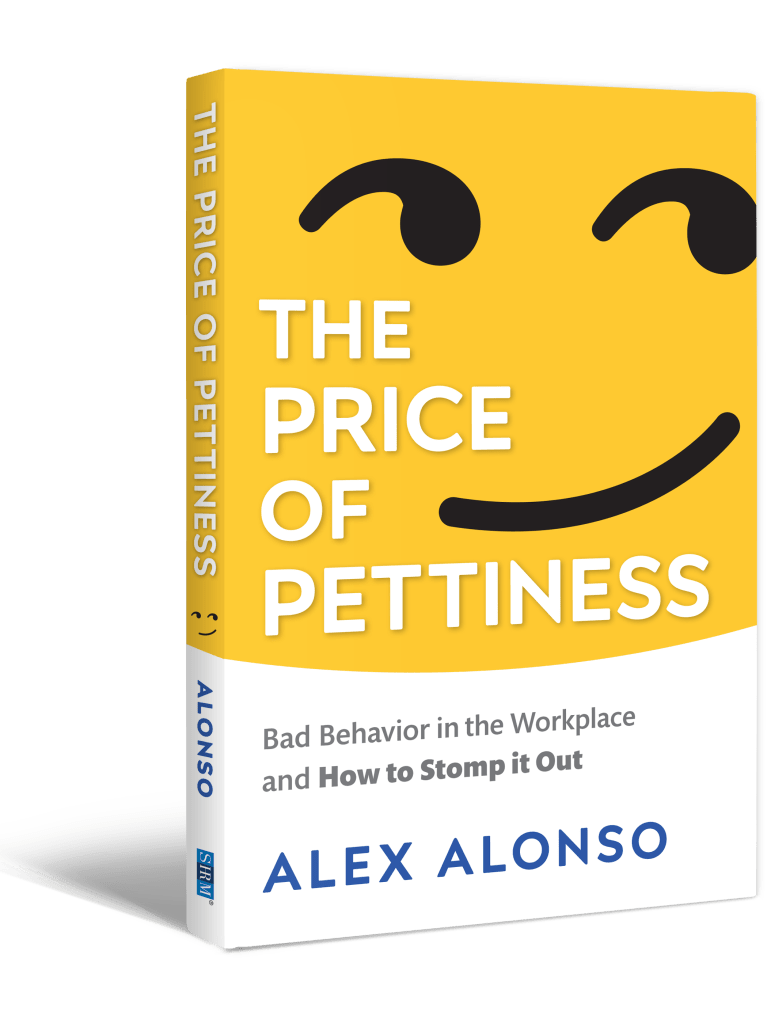This is the second of three excerpts adapted from The Price of Pettiness (SHRM, 2019), written by Alexander Alonso, Ph.D., SHRM-SCP.
According to SHRM's 2019 Pettiness in the Workplace Survey, 97 percent of people report having engaged in petty behavior. To a social scientist, that figure is jaw-dropping—it indicates that the pettiness phenomenon is pervasive. It's downright ubiquitous.
Knowing that most people are or have been petty is liberating, in a way. Now what?
We also know that everyone holds a certain level of self-awareness, making them cognizant of their own behaviors. And it's a given that everyone would benefit from less pettiness in themselves and others.
So, the opportunity presents itself: to reduce the prevalence of pettiness by helping people focus on their own behaviors. Let's make that a real-life challenge. What would it take to stomp out most pettiness? I believe it starts with our personal perspectives.
The STOMP Checklist: Self-Assessment
The Stomp Out Most Pettiness (STOMP) Checklist provides an overview of the petty behaviors you encounter every day, as well as a way to quantify their prevalence in your life in the form of a Pettiness Index.
The STOMP Checklist is fairly intuitive. Each behavior listed was identified using a content validation survey of 15,000 professionals in the U.S. workforce. Surely you recognize almost everything on the list, even if you haven't seen them described so impassively.
The behaviors are weighted according to how frequently they are practiced. Their frequency is inversely related to their severity and, potentially, their consequences. For example, complaining about noise levels is a fairly common thing to do, with minimal severity and hardly any consequences; as a result, this listed behavior is weighted as 1 for severity. By contrast, throwing a tantrum is a much more potentially detrimental activity; as such, it is weighted as 4.
While severity weightings are important, they are not the only factor to consider when thinking about one's own behavior. How often do you engage in these behaviors?
So how does one use the STOMP Checklist? I recommend it to identify two things in your life:
- Your most frequent petty behaviors (and how frequently you engage in them); and
- How many high-level behaviors (Level-4 severity) you engage in.
The first will give you an overall perspective of how your pettiness compares to other people's. The second will help you understand the aspects of your pettiness with the greatest potential for life-altering consequences.
The STOMP Checklist is also useful for self-monitoring your performance on the job. Performance is the most important behavior in any organization. Pettiness often precedes poor teamwork, failure to meet goals, company policy violations, and other indicators of low performance. As a result, monitoring your own pettiness is often likely to improve your performance. High performers tend to monitor their performance more often and more deeply than low performers.
The STOMP Checklist
| How often do you engage in the following behaviors? | WEIGHT | Never (-5) | Hardly (1) | Monthly (5) | Daily (10) |
| Act immaturely or childishly | 3 | | | | |
| Act unprofessionally | 2 | | | | |
| Complain about noise levels | 1 | | | | |
| Complain about odors from food or other sources | 2 | | | | |
| Criticize or ridicule someone for being intelligent | 4 | | | | |
| Devote obsessive attention to inconsequential matters | 3 | | | | |
| Do not stop infighting among team members/ within or between teams in other business units | 3 | | | | |
| Discount someone's contributions because of a personal bias or dislike | 3 | | | | |
| Exclude key stakeholders from meetings/ discussions/communications | 4 | | | | |
| Generally contribute to or do nothing to address an overall environment of pettiness | 3 | | | | |
| Instigate or encourage infighting among team members/within or between teams in other business units | 4 | | | | |
| Ostracize someone who has new ideas | 4 | | | | |
| Pick on someone who is unpopular | 4 | | | | |
| Play practical jokes | 3 | | | | |
| Push a personal agenda | 2 | | | | |
| Refuse to acknowledge someone's contributions | 4 | | | | |
| Refuse to work with someone | 3 | | | | |
| Suggest that someone lacks intelligence | 1 | | | | |
| Throw a tantrum | 4 | | | | |
| Take credit for someone's work or the work of a team | 4 | | | | |
| Torpedo, derail or cancel someone's project because of personal bias or dislike | 4 | | | | |
| Undermine a boss or co-worker to their peers | 3 | | | | |
| Undermine a boss or co-worker to their superiors | 3 | | | | |
| Withhold information from those who needed it to perform their work | 3 | | | | |
| TOTAL = ? = Pettiness Index | | |
Alexander Alonso, Ph.D., SHRM-SCP, is SHRM's Chief Knowledge Officer.
Visit the SHRMStore to order a copy of The Price of Pettiness.



